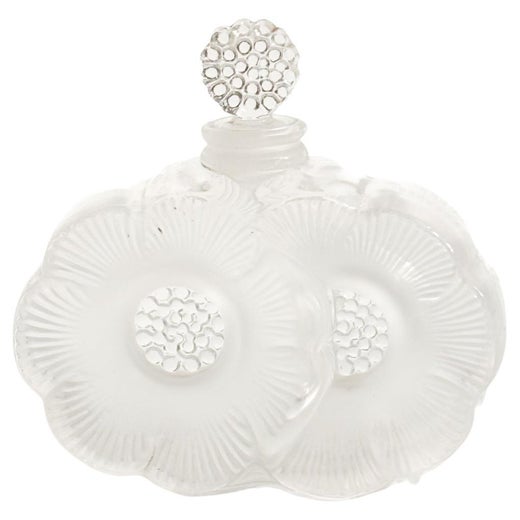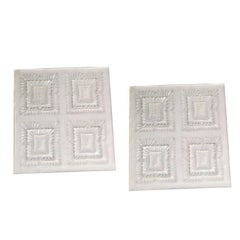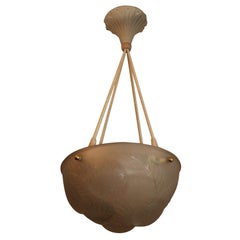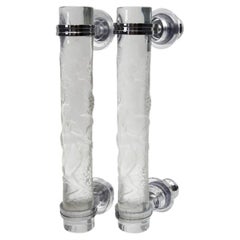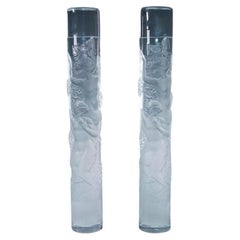Art Deco Architectural Glass Panels by Lalique
About the Item
- Creator:Lalique (Designer)
- Dimensions:Height: 17.75 in (45.09 cm)Width: 5.88 in (14.94 cm)
- Materials and Techniques:
- Place of Origin:
- Period:
- Date of Manufacture:after 1945
- Condition:Wear consistent with age and use.
- Seller Location:Bridgewater, CT
- Reference Number:1stDibs: 1301108015676
Lalique
Lalique is a beacon of French opulence in glassmaking and decorative arts, an enduring brand with a history spanning over 130 years and at least three movements in art and design: Art Nouveau, Art Deco and modernism. The firm’s founder, René Lalique, is a celebrated figure in Art Nouveau jewelry, which drew on feminine forms and natural-world themes. Under his masterful leadership, Lalique came to be known for its gorgeous vases, sculptures and glass and crystal serveware.
Rene Laliqué was born in 1860 in Aÿ-en-Champagne, France. As a young man, he apprenticed under Parisian Art Nouveau jeweler Louis Aucoc and studied at L'École nationale supérieure des Arts Décoratifs. Lalique's skill and esteem broadened, and he created jewelry for renowned houses like Cartier and Boucheron. He took over a workshop in Paris in 1885 and opened his own business soon afterward. Not one to follow trends, Lalique gained popularity for his innovative accessories, which merged glass, enamel and ivory — materials that were uncommon in jewelry-making — with semi-precious stones and metals. Lalique’s work gained greater prominence at the 1900 Paris Exhibition, which served as a showcase for his extraordinary designs.
In 1907, Lalique began a revolutionary partnership with French perfumer François Coty. He designed a line of molded glass perfume bottles with frosted surfaces and patterned reliefs. Lalique opened his eponymous glassworks in Combs-La-Ville, Paris, in 1909. His attractive bottles and other pieces were shown at the International Exhibition of Modern Decorative and Industrial Arts in 1925 — the event that brought Art Deco to worldwide attention — catapulting Lalique to new levels of fame. Shortly afterward, in 1927, he created one of his most iconic pieces: the Bacchantes vase. A marvel of glassmaking that convincingly depicted movement, the vase displays his technical skills and artistry.
Lalique began receiving high-profile commissions — in 1929, he decorated the luxurious Côte d’Azur Pullman Express carriages, and in 1935, he designed lighting for the Grand Salon and dining room on the ocean liner SS Normandie.
Lalique died in 1945, and the reins at the company were passed to his son, Marc Lalique. The firm continued to produce its signature glass pieces as well as crystal vases, decor and serveware. Marc's daughter, Marie-Claude Lalique, became CEO in 1977. She renewed the traditional jewelry and fragrance side of the business. In 2008, Lalique was acquired by Art & Fragrance, now known as Lalique Group. It remains a well-regarded lifestyle brand underpinned by a rich history in glassmaking.
On 1stDibs, find vintage Lalique decorative objects, lighting, tables and more.
You May Also Like
Antique 19th Century Asian Architectural Elements
Stone
20th Century French Art Deco Panelling
Art Glass
Antique 18th Century and Earlier Italian Panelling
Wood
20th Century Dutch Panelling
Fabric, Mahogany
Antique 19th Century French Régence Architectural Elements
Oak
Antique 19th Century American Industrial Architectural Elements
Plaster, Paint
Antique 19th Century Indian Anglo-Indian Panelling
Brass
20th Century French Louis XVI Panelling
Wood
Antique 16th Century Spanish Architectural Elements
Wood
Antique 19th Century English Renaissance Revival Panelling
Wood, Pine
More From This Seller
View AllVintage 1930s French Art Deco Panelling
Glass
Vintage 1930s French Art Deco Chandeliers and Pendants
Glass
Vintage 1960s French Mid-Century Modern Architectural Elements
Crystal
Vintage 1980s French Art Deco Architectural Elements
Crystal
Late 20th Century French Mid-Century Modern Console Tables
Glass
20th Century French Art Deco Chandeliers and Pendants
Glass
